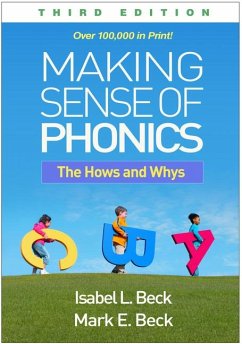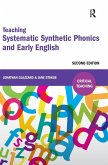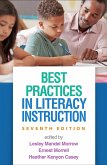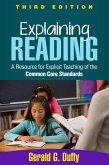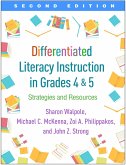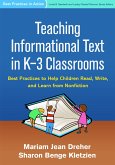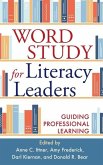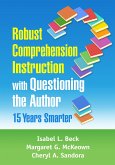- Gebundenes Buch
- Merkliste
- Auf die Merkliste
- Bewerten Bewerten
- Teilen
- Produkt teilen
- Produkterinnerung
- Produkterinnerung
Now in a revised and updated third edition incorporating a decade of additional research and classroom experience, this book has helped over 100,000 primary-grades teachers understand and successfully apply the science of reading in phonics instruction.
Andere Kunden interessierten sich auch für
![Teaching Systematic Synthetic Phonics and Early English Teaching Systematic Synthetic Phonics and Early English]() Jonathan GlazzardTeaching Systematic Synthetic Phonics and Early English169,99 €
Jonathan GlazzardTeaching Systematic Synthetic Phonics and Early English169,99 €![Best Practices in Literacy Instruction Best Practices in Literacy Instruction]() Best Practices in Literacy Instruction77,99 €
Best Practices in Literacy Instruction77,99 €![Explaining Reading Explaining Reading]() Gerald G DuffyExplaining Reading74,99 €
Gerald G DuffyExplaining Reading74,99 €![Differentiated Literacy Instruction in Grades 4 and 5 Differentiated Literacy Instruction in Grades 4 and 5]() Sharon WalpoleDifferentiated Literacy Instruction in Grades 4 and 557,99 €
Sharon WalpoleDifferentiated Literacy Instruction in Grades 4 and 557,99 €![Teaching Informational Text in K-3 Classrooms Teaching Informational Text in K-3 Classrooms]() Mariam Jean DreherTeaching Informational Text in K-3 Classrooms76,99 €
Mariam Jean DreherTeaching Informational Text in K-3 Classrooms76,99 €![Word Study for Literacy Leaders Word Study for Literacy Leaders]() Word Study for Literacy Leaders73,99 €
Word Study for Literacy Leaders73,99 €![Robust Comprehension Instruction with Questioning the Author Robust Comprehension Instruction with Questioning the Author]() Isabel L BeckRobust Comprehension Instruction with Questioning the Author51,99 €
Isabel L BeckRobust Comprehension Instruction with Questioning the Author51,99 €-
-
-
Now in a revised and updated third edition incorporating a decade of additional research and classroom experience, this book has helped over 100,000 primary-grades teachers understand and successfully apply the science of reading in phonics instruction.
Produktdetails
- Produktdetails
- Verlag: Guilford Publications
- 3rd edition
- Seitenzahl: 244
- Erscheinungstermin: 1. September 2024
- Englisch
- Abmessung: 254mm x 178mm x 16mm
- Gewicht: 667g
- ISBN-13: 9781462555369
- ISBN-10: 1462555365
- Artikelnr.: 70351007
- Herstellerkennzeichnung
- Libri GmbH
- Europaallee 1
- 36244 Bad Hersfeld
- gpsr@libri.de
- Verlag: Guilford Publications
- 3rd edition
- Seitenzahl: 244
- Erscheinungstermin: 1. September 2024
- Englisch
- Abmessung: 254mm x 178mm x 16mm
- Gewicht: 667g
- ISBN-13: 9781462555369
- ISBN-10: 1462555365
- Artikelnr.: 70351007
- Herstellerkennzeichnung
- Libri GmbH
- Europaallee 1
- 36244 Bad Hersfeld
- gpsr@libri.de
Isabel L. Beck, PhD, is Professor Emerita of Education at the University of Pittsburgh. She has conducted extensive research and published widely on decoding, vocabulary, and comprehension. Dr. Beck is a recipient of the Oscar S. Causey Award from the Literacy Research Association, the William S. Gray Citation of Merit from the International Literacy Association, and the Contributing Researcher Award from the American Federation of Teachers. She was inducted into the Reading Hall of Fame and is an elected member of the National Academy of Education. Her books include Bringing Words to Life, Second Edition; Creating Robust Vocabulary; Illuminating Comprehension and Close Reading; Making Sense of Phonics, Third Edition; and Robust Comprehension Instruction with Questioning the Author. Mark E. Beck, MEd, is a reading specialist at Manchester Academic Charter School in Pittsburgh, where he works with children in grades K¿5. After practicing law for 14 years, Mr. Beck changed careers, obtaining his Pennsylvania elementary teaching certification and working as a classroom teacher. Subsequently he obtained his reading specialist certification. He has also been a part-time instructor in the Reading Department in the School of Education at the University of Pittsburgh.
Preface
1. What Is the Forecast for Phonics Instruction in the United States?
2. The Alphabetic Principle and Phonics
3. Phonemic Awareness
4. The Phonics Landscape
5. Teaching Children the Sounds That Letters Represent
6. Blending
7. Word Building: Overview and Procedures
8. Word Building: Grouping
9. Assessment
10. Multisyllabic Words
11. Syllasearch
12. Orthography: A "Sticking Point in Word Recognition"
13. Fluency
Epilogue
Appendix 1.Word Building Lists
Appendix 2. Specific Phonics Assessments: Administration and Scoring
Guidelines
Appendix 3. The Word Pocket
Appendix 4. Words and Syllable Matrices for Syllasearch
Appendix 5. List of Online Teaching Resources
Glossary
References
Index
1. What Is the Forecast for Phonics Instruction in the United States?
2. The Alphabetic Principle and Phonics
3. Phonemic Awareness
4. The Phonics Landscape
5. Teaching Children the Sounds That Letters Represent
6. Blending
7. Word Building: Overview and Procedures
8. Word Building: Grouping
9. Assessment
10. Multisyllabic Words
11. Syllasearch
12. Orthography: A "Sticking Point in Word Recognition"
13. Fluency
Epilogue
Appendix 1.Word Building Lists
Appendix 2. Specific Phonics Assessments: Administration and Scoring
Guidelines
Appendix 3. The Word Pocket
Appendix 4. Words and Syllable Matrices for Syllasearch
Appendix 5. List of Online Teaching Resources
Glossary
References
Index
Preface
1. What Is the Forecast for Phonics Instruction in the United States?
2. The Alphabetic Principle and Phonics
3. Phonemic Awareness
4. The Phonics Landscape
5. Teaching Children the Sounds That Letters Represent
6. Blending
7. Word Building: Overview and Procedures
8. Word Building: Grouping
9. Assessment
10. Multisyllabic Words
11. Syllasearch
12. Orthography: A "Sticking Point in Word Recognition"
13. Fluency
Epilogue
Appendix 1.Word Building Lists
Appendix 2. Specific Phonics Assessments: Administration and Scoring
Guidelines
Appendix 3. The Word Pocket
Appendix 4. Words and Syllable Matrices for Syllasearch
Appendix 5. List of Online Teaching Resources
Glossary
References
Index
1. What Is the Forecast for Phonics Instruction in the United States?
2. The Alphabetic Principle and Phonics
3. Phonemic Awareness
4. The Phonics Landscape
5. Teaching Children the Sounds That Letters Represent
6. Blending
7. Word Building: Overview and Procedures
8. Word Building: Grouping
9. Assessment
10. Multisyllabic Words
11. Syllasearch
12. Orthography: A "Sticking Point in Word Recognition"
13. Fluency
Epilogue
Appendix 1.Word Building Lists
Appendix 2. Specific Phonics Assessments: Administration and Scoring
Guidelines
Appendix 3. The Word Pocket
Appendix 4. Words and Syllable Matrices for Syllasearch
Appendix 5. List of Online Teaching Resources
Glossary
References
Index

